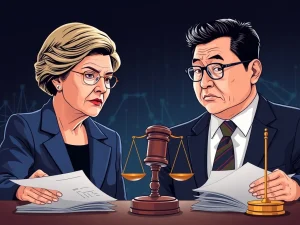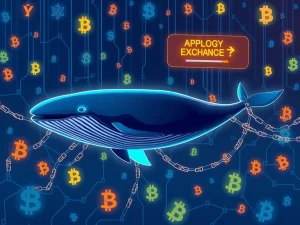Tron’s Risky Gamble: TRX as Corporate Collateral Could Implode

Justin Sun’s Tron is making a bold move that challenges traditional finance: using its native cryptocurrency, TRX, as a central asset in its corporate treasury. This strategy, part of a planned reverse merger, is unprecedented for a U.S. publicly traded company and comes with significant risks that could impact the company and the broader crypto market.
Tron’s Reverse Merger and the TRX Strategy
Toy maker SRM Entertainment recently announced its plan to rebrand as Tron Inc and adopt a treasury strategy focused on holding TRX. This move, often described as a reverse merger, is backed by a substantial investment, potentially reaching $210 million. Justin Sun will serve as an adviser.
While some public companies have added Bitcoin (BTC) to their balance sheets, Tron’s approach with TRX is notably different and potentially riskier. TRX is the native token of the Tron blockchain, making its value closely tied to the company itself. Using it as a primary corporate reserve creates a circular relationship that raises concerns.
Why Using TRX as a Crypto Treasury is Risky
Experts highlight several risks associated with Tron Inc holding TRX as a corporate asset:
- Circularity: As Jamie Elkaleh of Bitget Wallet notes, the company is essentially holding its own equity-like asset as collateral. If confidence in Tron Inc drops, the value of TRX could fall, further decreasing Tron Inc’s perceived value in a negative feedback loop.
- Liquidity: Despite its high market cap, TRX has significantly lower trading volume compared to Bitcoin. This lack of deep institutional demand and liquidity could make it challenging for Tron Inc to manage its treasury holdings, especially during market downturns.
- Centralization: TRX is often perceived as more centrally controlled than Bitcoin, which could be a concern for investors looking for decentralized corporate treasury assets.
- Regulatory Uncertainty: Tron and Justin Sun already face ongoing legal challenges from the SEC regarding the sale of unregistered securities (including TRX). Holding TRX as a corporate asset could introduce additional regulatory complications if TRX is deemed a security.
Comparing Tron’s Approach to Others
MicroStrategy, led by Michael Saylor, pioneered the aggressive Bitcoin treasury strategy. While that approach inspired other firms, the market reaction to crypto treasury announcements is no longer guaranteed positive. Tron’s plan differs significantly:
- MicroStrategy (BTC): Holds Bitcoin, a widely recognized, highly liquid, and decentralized asset with growing institutional interest. Saylor’s strategy is well-established with clear processes.
- Tron Inc (TRX): Plans to hold its own network’s token, an asset with lower liquidity, perceived centralization, and direct ties to the company’s fate.
Comparing Tron’s reverse merger path to a traditional IPO like Circle’s also highlights differences. Circle, issuing the USDC stablecoin, pursued a more conventional and transparent public offering route, which experts like Yuriy Brisov of Digital and Analogue Partners suggest is generally preferred by investors hesitant about crypto firms. Reverse mergers, while faster, have a history of facing increased scrutiny.
The Eric Trump Connection and Regulatory Clouds
The announcement also involved reported ties to Eric Trump, son of former President Donald Trump, who later denied direct involvement but is connected to Dominari Securities, the deal’s placement agent. Eric Trump and his brother joined Dominari’s advisory board in February. This association, coupled with Justin Sun’s public support for Trump-linked crypto projects, adds another layer of complexity and potential scrutiny.
Furthermore, the existing SEC case against Justin Sun and his companies regarding TRX and BTT sales looms large. The SEC alleges these were unregistered securities. If a court agrees, holding TRX as a corporate asset could trigger significant compliance challenges for Tron Inc.
Tron’s Network Activity vs. Treasury Risk
Despite the risks associated with the TRX treasury strategy, it’s important to note that the Tron network itself remains highly active. It plays a major role in stablecoin flows, particularly as the largest network for Tether’s USDt circulation globally. This underlying activity provides a foundation, but it doesn’t mitigate the specific risks of using TRX as the primary corporate reserve asset in a publicly traded structure.
Conclusion: A High-Stakes Bet
Tron’s planned reverse merger and its strategy to center its corporate treasury around TRX represent a high-stakes bet. It pushes the boundaries of what’s considered a legitimate corporate asset on Wall Street. While the Tron network has proven resilient, the circular relationship between Tron Inc and TRX, coupled with liquidity concerns and ongoing regulatory challenges for Justin Sun and Tron, creates a scenario where the company’s Wall Street hopes could potentially implode if confidence wavers or regulators intensify scrutiny. This move will be a critical test case for crypto adoption in corporate finance.









